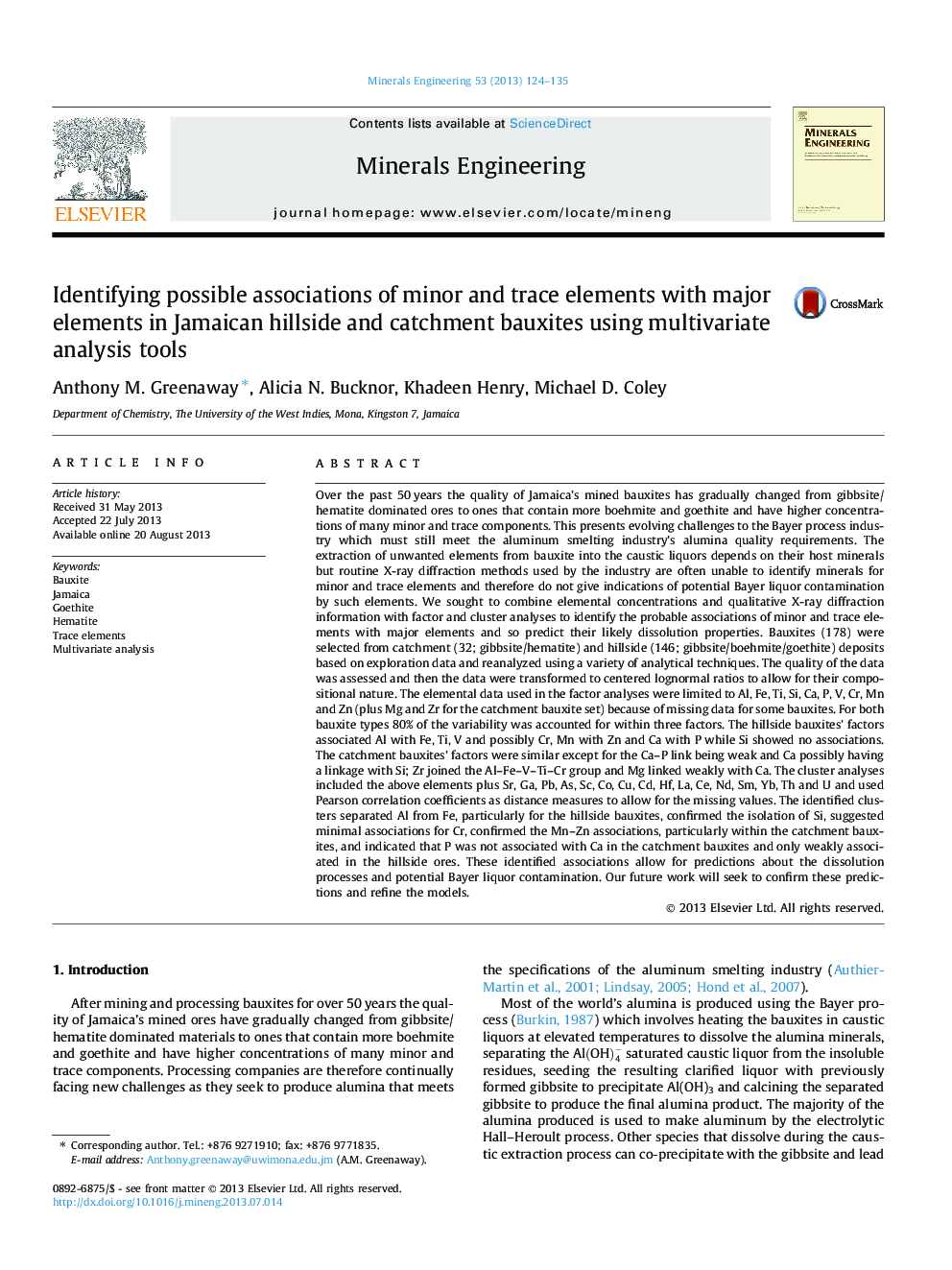| کد مقاله | کد نشریه | سال انتشار | مقاله انگلیسی | نسخه تمام متن |
|---|---|---|---|---|
| 233383 | 465337 | 2013 | 12 صفحه PDF | دانلود رایگان |

• Jamaican catchment (gibbsite/hematite) and hillside (gibbsite/goethite) bauxites.
• Lognormal-centre-ratioed 32 elemental concentrations for multivariate analyses.
• Hillside bauxites had Al–Fe–Ti–V–Cr, Mn–Zn and Ca–P groupings within factors.
• Catchment bauxites had Al–Fe–Ti–V–Cr and Mn–Zn groupings within factors.
• Clusters refined factor groupings and indicate potential Bayer liquor contamination.
Over the past 50 years the quality of Jamaica’s mined bauxites has gradually changed from gibbsite/hematite dominated ores to ones that contain more boehmite and goethite and have higher concentrations of many minor and trace components. This presents evolving challenges to the Bayer process industry which must still meet the aluminum smelting industry’s alumina quality requirements. The extraction of unwanted elements from bauxite into the caustic liquors depends on their host minerals but routine X-ray diffraction methods used by the industry are often unable to identify minerals for minor and trace elements and therefore do not give indications of potential Bayer liquor contamination by such elements. We sought to combine elemental concentrations and qualitative X-ray diffraction information with factor and cluster analyses to identify the probable associations of minor and trace elements with major elements and so predict their likely dissolution properties. Bauxites (178) were selected from catchment (32; gibbsite/hematite) and hillside (146; gibbsite/boehmite/goethite) deposits based on exploration data and reanalyzed using a variety of analytical techniques. The quality of the data was assessed and then the data were transformed to centered lognormal ratios to allow for their compositional nature. The elemental data used in the factor analyses were limited to Al, Fe, Ti, Si, Ca, P, V, Cr, Mn and Zn (plus Mg and Zr for the catchment bauxite set) because of missing data for some bauxites. For both bauxite types 80% of the variability was accounted for within three factors. The hillside bauxites’ factors associated Al with Fe, Ti, V and possibly Cr, Mn with Zn and Ca with P while Si showed no associations. The catchment bauxites’ factors were similar except for the Ca–P link being weak and Ca possibly having a linkage with Si; Zr joined the Al–Fe–V–Ti–Cr group and Mg linked weakly with Ca. The cluster analyses included the above elements plus Sr, Ga, Pb, As, Sc, Co, Cu, Cd, Hf, La, Ce, Nd, Sm, Yb, Th and U and used Pearson correlation coefficients as distance measures to allow for the missing values. The identified clusters separated Al from Fe, particularly for the hillside bauxites, confirmed the isolation of Si, suggested minimal associations for Cr, confirmed the Mn–Zn associations, particularly within the catchment bauxites, and indicated that P was not associated with Ca in the catchment bauxites and only weakly associated in the hillside ores. These identified associations allow for predictions about the dissolution processes and potential Bayer liquor contamination. Our future work will seek to confirm these predictions and refine the models.
Journal: Minerals Engineering - Volume 53, November 2013, Pages 124–135